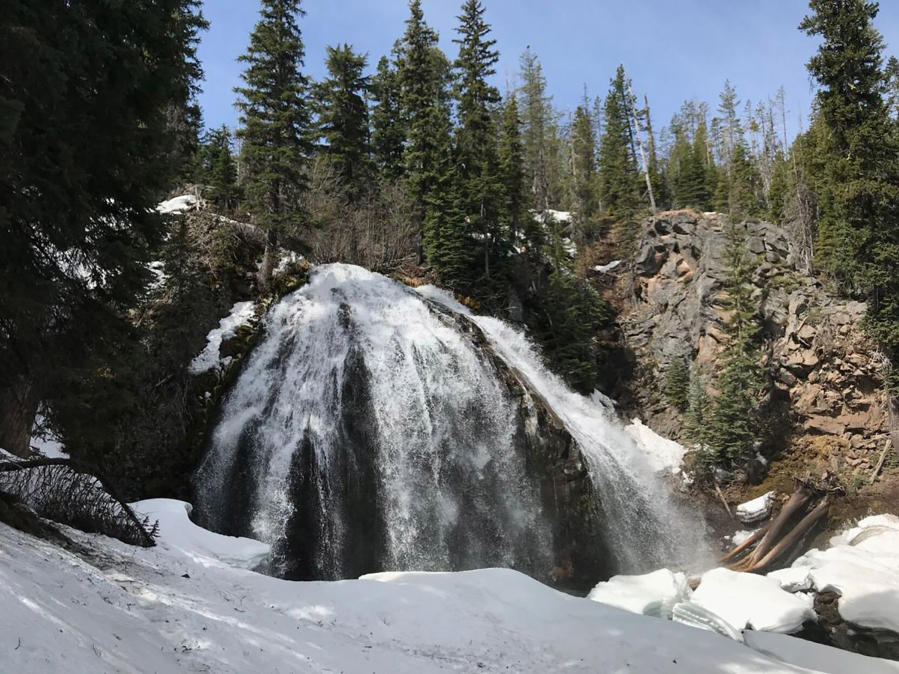BEND, Ore. — It is going to be a hiking season unlike any other in Central Oregon.
Starting May 28, access to many of our favorite trails in the Three Sisters Wilderness will require a Central Cascades Wilderness permit, purchased in advance and subject to availability.
Gone are the days of an impromptu midsummer Saturday trek to the summit of South Sister or up to Green Lakes. But most trails in our beloved wilderness will still only require a free, self-issue permit available at the trailhead.
One such trail is Chush Falls. Located south of Sisters off Forest Road 16 and along Upper Whychus Creek, the 5-mile round-trip hike to this beautiful waterfall is a perfect way to kick off the hiking season.
The trailhead is not easy to find, as it requires driving about 6 miles on gravel forest roads.
On a cold, high-overcast morning recently, I started the trek from the Chush Falls Trailhead, following the path of destruction of the 2012 Pole Creek Fire. Trees on both sides of Whychus Creek were charred black, and North Sister and Middle Sister rose to the west, blanketed white with lingering snow.
The first portion of the trail passes through the severely scorched forest. Wide and not at all technical, the trail — which ascends moderately from 4,800 feet to 5,200 feet in elevation — cuts through a mixed-conifer forest and crosses two small tributary creeks.
Snow and deadfall still covered the trail in certain areas. Warmer temperatures on the horizon will help to melt some of the snow. At one section where downed trees seemed to block the trail, I stayed to the right and crossed a small creek, and the trail continued.
I could hear the waterfall, a rushing cascade growing in intensity as I drew closer. From a small overlook, I glanced down at the waterfall, which is about 70 feet high and 80 feet wide. Upper Whychus Creek surges strong all year, as it is fed by snowmelt and glaciers from Broken Top, Middle Sister and North Sister.
A steep and challenging unmarked trail leads to the base of the waterfall, and I managed to carefully negotiate my way down through the snow.
Once down to the creek, I glanced at the waterfall that rose before me, a seemingly hidden gem in the middle of the quiet forest. The water splashed off the surrounding rocks and snow with intensity.
After making my way back up to the main trail, I viewed the falls from high above, a much easier way to enjoy the waterfall than making the perilous trip down the unmarked trail.
I made my way back toward Chush Falls and then on to the main trailhead. The Three Sisters rose above the fire-altered forest as Whychus Creek carved through the canyon.
According to the Deschutes National Forest, the Pole Creek Fire (26,584 acres) led to significant alterations of both the trailhead and the trail itself. The U.S. Forest Service closed some roads and rerouted the driving approach to the trailhead and the trail.
Before the changes, the hike to Chush (pronounced SHOOSH) Falls was barely more than a mile. Now the hike is 2.5 miles.
Much restoration work has taken place on Whychus Creek in recent years to help restore the native fish species of redband trout, steelhead and chinook salmon. The Forest Service asks hikers to respect the restoration work by avoiding areas marked as closed and using only existing roads and trails.
Twelve trailheads in the Three Sisters Wilderness will require advance permits, which went on sale April 6 at recreation.gov. According to the Forest Service, the remainder of the day-use permits — between 50 percent and 80 percent — will be released on a seven-day rolling window on May 28.
“The 7-day rolling window means that every day new permits will be available,” the Forest Service website says.
The permit system will apply to the period May 28 through Sept. 24. A helpful online map shows which trailheads require that a Central Cascades Wilderness permit be purchased in advance.



